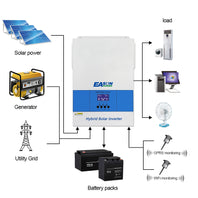As the renewable energy industry continues to expand, the role of dual-function grid-tied solar inverters has become increasingly significant. These innovative devices play a crucial role in converting the direct current (DC) generated by solar panels into alternating current (AC) for use in homes and businesses. In this article, we will explore the numerous benefits of dual-function grid-tied solar inverters and their impact on the renewable energy sector.

Enhanced Efficiency
One of the primary benefits of dual-function grid-tied solar inverters is their ability to enhance the overall efficiency of solar power systems. By integrating the functions of a solar inverter and a battery inverter, these devices streamline the energy conversion process and minimize energy losses. This increased efficiency not only maximizes the utilization of solar energy but also reduces the overall operational costs of solar power systems.
Optimized Energy Management
Another advantage of dual-function grid-tied solar inverters is their capability to optimize energy management within renewable energy systems. These inverters enable seamless integration with energy storage systems, allowing for the efficient utilization of stored energy during periods of low solar generation. This flexibility in energy management ensures a reliable and consistent power supply, even during adverse weather conditions or grid outages.
Grid Support Functionality
Dual-function grid-tied solar inverters also offer grid support functionality, which is essential for the stability and reliability of the electrical grid. These inverters can regulate voltage and frequency levels, provide reactive power support, and contribute to grid stabilization. By actively participating in grid support functions, dual-function grid-tied solar inverters contribute to the overall resilience of the electricity grid and facilitate the integration of higher levels of renewable energy.
Cost-Effective Solution
From a financial perspective, the adoption of dual-function grid-tied solar inverters presents a cost-effective solution for both solar power system owners and grid operators. The integration of multiple functionalities into a single device reduces the need for separate inverters and additional equipment, resulting in lower installation and maintenance costs. Furthermore, the enhanced operational efficiency and grid support capabilities of these inverters contribute to long-term cost savings for all stakeholders in the renewable energy industry.
In conclusion, the exploration of the benefits of dual-function grid-tied solar inverters in the renewable energy industry highlights their pivotal role in advancing the adoption of solar power systems and promoting grid stability. As the demand for clean and sustainable energy continues to grow, the versatility and efficiency of dual-function grid-tied solar inverters will undoubtedly play a crucial role in shaping the future of the renewable energy landscape.








